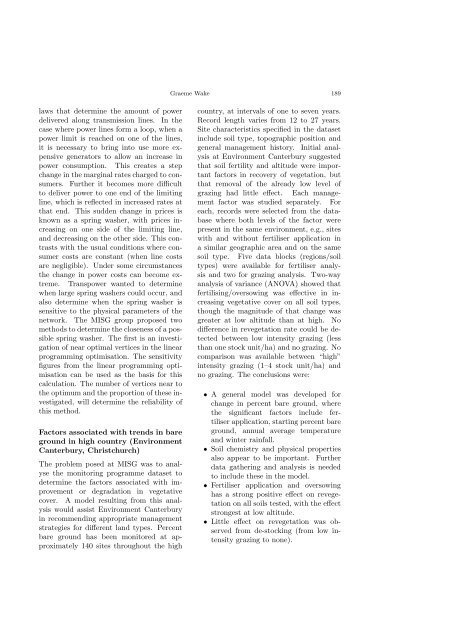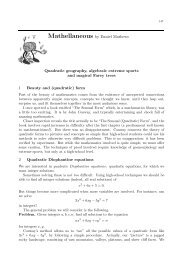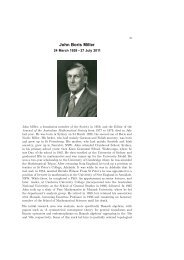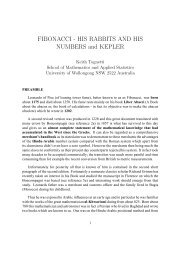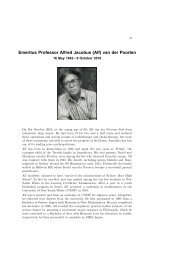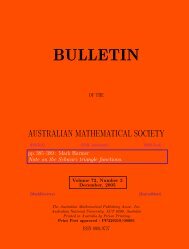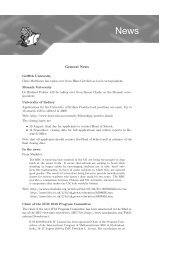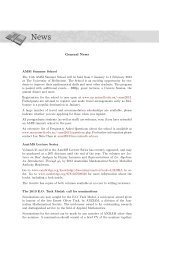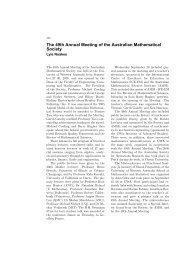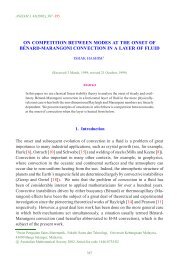Gazette 31 Vol 3 - Australian Mathematical Society
Gazette 31 Vol 3 - Australian Mathematical Society
Gazette 31 Vol 3 - Australian Mathematical Society
You also want an ePaper? Increase the reach of your titles
YUMPU automatically turns print PDFs into web optimized ePapers that Google loves.
laws that determine the amount of power<br />
delivered along transmission lines. In the<br />
case where power lines form a loop, when a<br />
power limit is reached on one of the lines,<br />
it is necessary to bring into use more expensive<br />
generators to allow an increase in<br />
power consumption. This creates a step<br />
change in the marginal rates charged to consumers.<br />
Further it becomes more difficult<br />
to deliver power to one end of the limiting<br />
line, which is reflected in increased rates at<br />
that end. This sudden change in prices is<br />
known as a spring washer, with prices increasing<br />
on one side of the limiting line,<br />
and decreasing on the other side. This contrasts<br />
with the usual conditions where consumer<br />
costs are constant (when line costs<br />
are negligible). Under some circumstances<br />
the change in power costs can become extreme.<br />
Transpower wanted to determine<br />
when large spring washers could occur, and<br />
also determine when the spring washer is<br />
sensitive to the physical parameters of the<br />
network. The MISG group proposed two<br />
methods to determine the closeness of a possible<br />
spring washer. The first is an investigation<br />
of near optimal vertices in the linear<br />
programming optimisation. The sensitivity<br />
figures from the linear programming optimisation<br />
can be used as the basis for this<br />
calculation. The number of vertices near to<br />
the optimum and the proportion of these investigated,<br />
will determine the reliability of<br />
this method.<br />
Factors associated with trends in bare<br />
ground in high country (Environment<br />
Canterbury, Christchurch)<br />
The problem posed at MISG was to analyse<br />
the monitoring programme dataset to<br />
determine the factors associated with improvement<br />
or degradation in vegetative<br />
cover. A model resulting from this analysis<br />
would assist Environment Canterbury<br />
in recommending appropriate management<br />
strategies for different land types. Percent<br />
bare ground has been monitored at approximately<br />
140 sites throughout the high<br />
Graeme Wake 189<br />
country, at intervals of one to seven years.<br />
Record length varies from 12 to 27 years.<br />
Site characteristics specified in the dataset<br />
include soil type, topographic position and<br />
general management history. Initial analysis<br />
at Environment Canterbury suggested<br />
that soil fertility and altitude were important<br />
factors in recovery of vegetation, but<br />
that removal of the already low level of<br />
grazing had little effect. Each management<br />
factor was studied separately. For<br />
each, records were selected from the database<br />
where both levels of the factor were<br />
present in the same environment, e.g., sites<br />
with and without fertiliser application in<br />
a similar geographic area and on the same<br />
soil type. Five data blocks (regions/soil<br />
types) were available for fertiliser analysis<br />
and two for grazing analysis. Two-way<br />
analysis of variance (ANOVA) showed that<br />
fertilising/oversowing was effective in increasing<br />
vegetative cover on all soil types,<br />
though the magnitude of that change was<br />
greater at low altitude than at high. No<br />
difference in revegetation rate could be detected<br />
between low intensity grazing (less<br />
than one stock unit/ha) and no grazing. No<br />
comparison was available between “high”<br />
intensity grazing (1–4 stock unit/ha) and<br />
no grazing. The conclusions were:<br />
• A general model was developed for<br />
change in percent bare ground, where<br />
the significant factors include fertiliser<br />
application, starting percent bare<br />
ground, annual average temperature<br />
and winter rainfall.<br />
• Soil chemistry and physical properties<br />
also appear to be important. Further<br />
data gathering and analysis is needed<br />
to include these in the model.<br />
• Fertiliser application and oversowing<br />
has a strong positive effect on revegetation<br />
on all soils tested, with the effect<br />
strongest at low altitude.<br />
• Little effect on revegetation was observed<br />
from de-stocking (from low intensity<br />
grazing to none).


